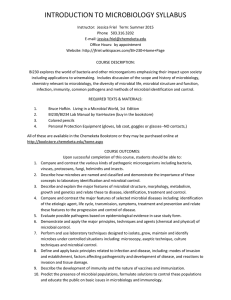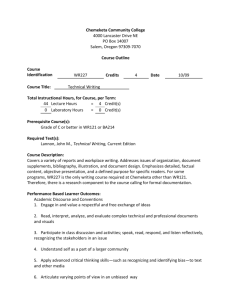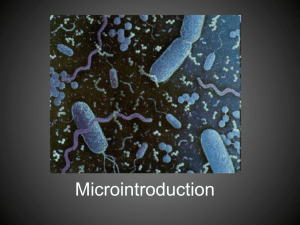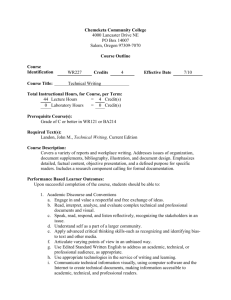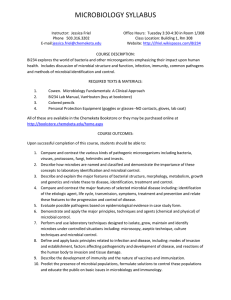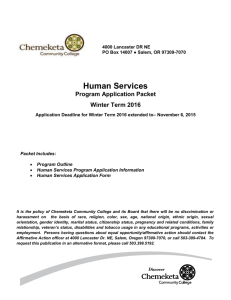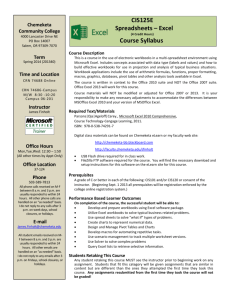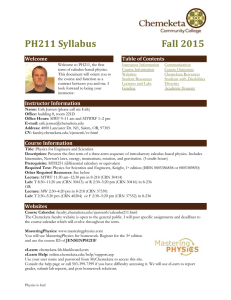MICROBIOLOGY SYLLABUS Instructor: Jessica Friel Term: Summer
advertisement
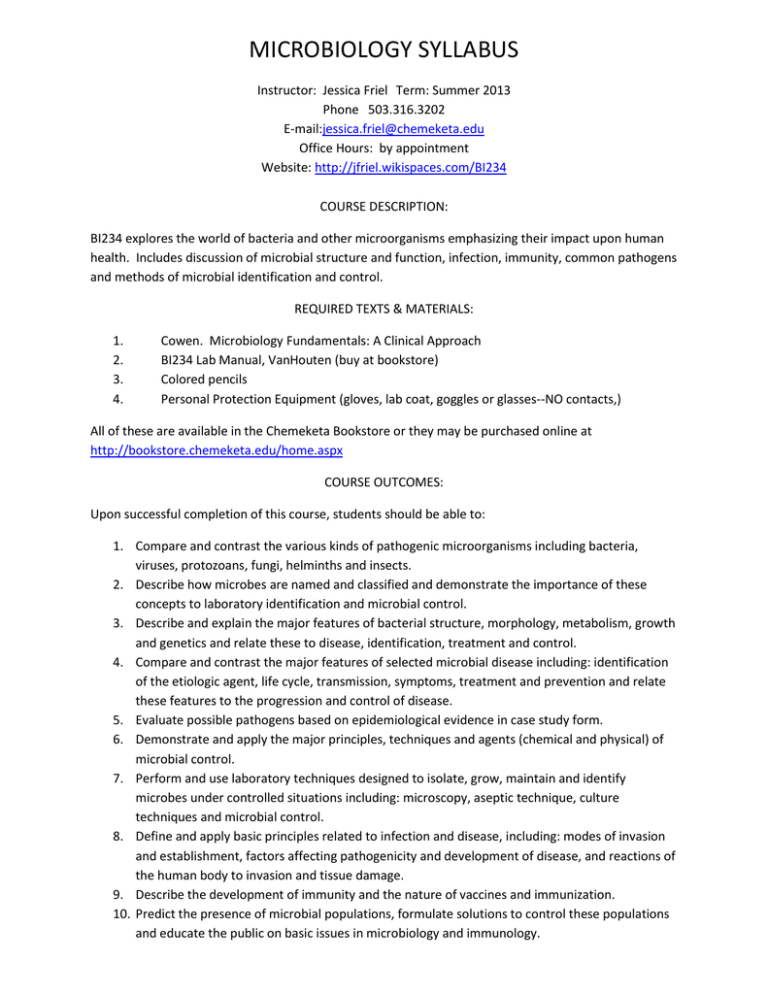
MICROBIOLOGY SYLLABUS Instructor: Jessica Friel Term: Summer 2013 Phone 503.316.3202 E-mail:jessica.friel@chemeketa.edu Office Hours: by appointment Website: http://jfriel.wikispaces.com/BI234 COURSE DESCRIPTION: BI234 explores the world of bacteria and other microorganisms emphasizing their impact upon human health. Includes discussion of microbial structure and function, infection, immunity, common pathogens and methods of microbial identification and control. REQUIRED TEXTS & MATERIALS: 1. 2. 3. 4. Cowen. Microbiology Fundamentals: A Clinical Approach BI234 Lab Manual, VanHouten (buy at bookstore) Colored pencils Personal Protection Equipment (gloves, lab coat, goggles or glasses--NO contacts,) All of these are available in the Chemeketa Bookstore or they may be purchased online at http://bookstore.chemeketa.edu/home.aspx COURSE OUTCOMES: Upon successful completion of this course, students should be able to: 1. Compare and contrast the various kinds of pathogenic microorganisms including bacteria, viruses, protozoans, fungi, helminths and insects. 2. Describe how microbes are named and classified and demonstrate the importance of these concepts to laboratory identification and microbial control. 3. Describe and explain the major features of bacterial structure, morphology, metabolism, growth and genetics and relate these to disease, identification, treatment and control. 4. Compare and contrast the major features of selected microbial disease including: identification of the etiologic agent, life cycle, transmission, symptoms, treatment and prevention and relate these features to the progression and control of disease. 5. Evaluate possible pathogens based on epidemiological evidence in case study form. 6. Demonstrate and apply the major principles, techniques and agents (chemical and physical) of microbial control. 7. Perform and use laboratory techniques designed to isolate, grow, maintain and identify microbes under controlled situations including: microscopy, aseptic technique, culture techniques and microbial control. 8. Define and apply basic principles related to infection and disease, including: modes of invasion and establishment, factors affecting pathogenicity and development of disease, and reactions of the human body to invasion and tissue damage. 9. Describe the development of immunity and the nature of vaccines and immunization. 10. Predict the presence of microbial populations, formulate solutions to control these populations and educate the public on basic issues in microbiology and immunology. PREREQUISITES: Required: BI231 and CH104 or CH110 Recommended: BI102, CH100, 105, 106, BI232 and BI233 It is expected that you have a basic understanding of chemical principles before you enter this class. In addition, anatomy and physiology are strongly recommended as a foundation for understanding human body function before, during and after microbial invasion. GRADING: Assessment Tool Laboratory Notebook Mystery Microbe Project Disease Presentation Midterms (2@100pts) Final Exam-Comprehensive Points ~76 ~40 30 200 200 Total (Tentative)--Total Points will fluctuate during the term Grade Scale 90%-100% 80-89% 70-79% 60-69% 59% and below ~546 Grade A B C D F NOTE: There are no make-up labs. If you miss more than 2 labs you will NOT receive credit for the course. No make-up quizzes or exams will be given, except under prearranged or special circumstances. Assignments turned in late will be marked down 50% per week. If you have a grade dispute, please submit a hard copy or e-mail explanation of your dispute and I will reply to you within 48 hours . COURSE REQUIREMENTS: Lecture Material-Lecture material will be presented in the form of PowerPoint lecture notes, class activities and online class discussion. You will find the Power Point lecture notes on the course web page. I also convert the files into a .pdf file which is easily read by the free program Adobe Acrobat. Laboratory Notebook-A laboratory notebook will serve as your legal record of events that occurred in the microbiology lab. It will be a place to outline your experiments, record data and present your conclusions about your experiments. For those students going into an Allied Health field, the laboratory notebook will help you develop organizational skills that will be necessary when documenting patient records. Laboratory Notebooks will be graded for their completeness, accuracy and neatness. Mystery Microbe Project-The unknown bacteria identification project is a way for you to become a microbe detective. Think of yourself as a lab technician who receives a patient sample and you must identify the specimen accurately to offer the patient the best treatment plan. You will perform experiments, collect data, analyze data and draw conclusions in order to identify your unknown bacterial species. You will receive a numbered tube the second week in lab and then perform experiments with your unknown each week. At the end of the quarter you should be able to correctly identify your unknown bacterial genus and species. Disease Presentation Project-Individuals or pairs of students will investigate the current literature and websites about a variety of diseases. Guidelines for these disease presentations will be discussed in class and posted on our class website. Midterms-Midterms will take place during the first hour of lab. They will be taken in the lab using a printed, hard copy exam not a computer. Midterms will be in the form of short answer, multiple choice, true/false, short essay, long essay and case study questions. If you can answer all of the questions at the end of each chapter, answer the questions on the textbook website and understand the power point notes you should be in good shape for the exams. Make sure you are especially comfortable with the lecture note material and learning objectives for the chapter. Final Exam-Like the midterms the final will also be a printed, hard copy exam. The final exam is cumulative meaning that all chapters will be fair game on the exam. A cumulative final allows you to review the class material and further store concepts into your long term memory. Don't let this scare you too much as students have performed similarly to their exams. You will be allowed to bring a "reference sheet" consisting of a single sided 8.5 x 11 in. COURSE RESOURCES AND POLICIES: Resources at Chemeketa— Please take advantage of Chemeketa's many resources!! :) You will notice direct links to some of these services at the bottom of our course content page and all the following services can be found on the starting course list page in Campus Edition 6: STUDENT SERVICES: Students with special needs should contact Disability Services (503.399.5192) for appropriate documentation of necessary accommodations. If you have emergency medical information or need special arrangements, please notify the instructor as soon as possible. The following is a list of services that are available to students at CCC: Resource URL and location Main Chemeketa website http://www.chemeketa.edu/ Chemeketa Online http://online.chemeketa.edu/ Bldg 9, Rm 106 503.399.7399 Counseling and Career Services CCC Counseling Bldg 2, first floor 503.399.5120 Includes CCC's counseling, testing and career services CCC Library CCC Library Bldg 9, second floor 503.399.5231 You will be amazed at the plethora of information found in the library with helpful tutorials or people to help you navigate through the info. Bookstore CCC Bookstore Bldg 1, first floor 503.399.5131 Using the bookstore link you can find out about texts required for your classes and even order them online along with other merchandise. Academic Support Services Includes the tutoring center where you can get help from a tutor, writing center to help with writing projects and study skills info. VERY USEFUL!! Student Support Services Many helpful services including resources for child care, disabilities, college access, international students, veterans and graduation. VERY USEFUL!! Student Responsibilities Includes policies regarding student rights and responsibilities including: privacy, harrassment, academic honesty, etc. Academic Support Services Student Support Services Student Rights and Responsibilities Disability Services Description This is Chemeketa's main site and includes links for the catalog, schedule, student services, college life and general campus information. Chemeketa Online's website with many links including Tech Help, FAQs, and an Online Orientation to name a few. http://www.chemeketa.edu/services/If you suspect or know that you have a disability disabilities/index.html or special need please utilize Chemeketa's Disability Bldg. 2, Room 174 or call:| V/TTY: 503-399-5192 ACADEMIC INTEGRITY: Services. ACADEMIC HONESTY STATEMENT: http://www.chemeketa.edu/earncertdegree/advising/studyskills/writing/resources/academichonesty/ Learning is built on the fundamental qualities of honesty, fairness, respect and trust. At Chemeketa Community College, academic integrity is a shared endeavor characterized by truth, personal responsibility and high academic standards. Any violation of academic integrity devalues the individual and the community as a whole. Violations of academic honesty include but are not limited to the following: plagiarism, cheating, collusion, fabrication / falsification /alteration, unauthorized submissions, and sabotage / tampering. Definition of Plagiarism: Plagiarism is defined as representing the words, ideas, or work of another as one’s own in any academic exercise. Plagiarism consists of taking the words or substance of another work and either copying or paraphrasing without giving credit to the source. Plagiarism is applicable to written, oral, and artistic work. The following examples are only some of the many forms plagiarism may take: 1. 2. 3. 4. Word-for-word copying of work written by someone else. Failure to give proper credit for ideas, statements of facts, or conclusions derived by another. Failure to use quotation marks when quoting directly from another, whether a paragraph, sentence, or phrase. Close and extended paraphrasing of another work without acknowledging the source. Definition of Cheating: Cheating is the act of obtaining or attempting to obtain credit for academic work through the use of dishonest, deceptive, or fraudulent means. The following are only some of the many forms cheating may take: 1. 2. 3. 4. 5. Copying another’s work on a test, paper, or project. Using unauthorized materials in an exam or collaborating on work to be turned in for credit where the instructor disallows such collaboration. Taking an exam for another student, purposely allowing another student to copy during a test, or providing coursework for another student to turn in as his or her own effort. Fabricating, falsifying or misrepresenting data or results from experiments, interviews or surveys. Submitting the same work in more than one class for credit without permission from the instructor. By taking this course, you agree to adhere to the Academic Honesty Guidelines. Infractions, such as cheating or plagiarism, WILL NOT BE TOLERATED and will be dealt with according to the policies of CCC. Any such infractions will constitute a violation of the college policy and will result in an appropriate consequence (e.g., zero on the assignment, an F for the course, etc.) at the discretion of the instructor and college officials. TECHNOLOGY RECOMMENDATIONS AND RESOURCES: Information Technology Help Desk at (503)399-7899 or Distance Education at (503)399-5191. Technology Recommendations Specific to this Course: 1. MS Word (if you do not have MS Word, please access a computer that does to download and print the Study Guide assignments and then complete them by hand.) 2. Power Point (if you do not have PowerPoint you can view lecture notes using the pdf files and Adobe Acrobat. For our disease project where Power Point is required you may need to complete your project using the Computer Lab found on the second floor of Building 6 on campus.) 3. Adobe Acrobat available as a free download and used to view the pdf files. PRIMARY TEACHING METHODS: Lecture material will be delivered in the form of study guide questions, the textbook, Power Point presentations, active learning activities, and question and answer discussions.. We will work with class material by performing laboratory experiments, discussing classic and current events and concepts in microbiology and doing activities such as case studies, active learning exercises and comprehensive projects such as the mystery microbe project and a disease presentation project. CLASSROOM RESPONSIBILITY: Full participation is expected of each student. All class and laboratory assignments must be completed individually and originally unless otherwise stated. If you miss a class, it is your responsibility to determine material missed, obtain handouts, and be aware of the class schedule. The ultimate basis for determining acceptable behavior and procedure in this class will be the Chemeketa Creed (printed in the college catalog) http://www.chemeketa.edu/ Basically, respect others as you would have them respect you. CHEMEKETA'S DIVERSITY STATEMENT: Chemeketa is a community college enriched by the diversity of our students and staff. Each individual and group has the potential to contribute in our learning environment. Each has dignity. To diminish the dignity of one is to diminish the dignity of us all. (from the college catalog) http://www.chemeketa.edu/ HOW MUCH TIME DO I NEED TO DEDICATE TO MICRO? Be prepared to spend at least 2 hours outside of class for every hour inside of class. You will be in class 6 hours a week and expected to study at least 12 more hours during the week. Times may vary from week to week. To prevent the amount of class time from getting overwhelming a great idea is to schedule shorter blocks of time into your schedule on a regular basis. For example, plan to study for 3 hours 5 days a week. You can even split that time up into 3 1 hour blocks to make it fit in to your schedule. Procrastination is a very bad option in this class since if you get behind it is extremely difficult to catch up so organize your schedule in advance! TIPS FOR SUCCESS: 1. Start with the "big picture" of each chapter by reading the Chapter Summary found at the end of each chapter. 2. Then, start filling in the "details" by completing the study guide assignments in a timely manner. 3. Assess your knowledge using the self-quizzes at the end of the chapter and the LearnSmart study modules on the textbook website. 4. Establish study partners with whom to study and discuss issues in microbiology. 5. Review each week's material and try to apply it to your everyday life. Note: Please contact me ASAP if you are having difficulties with this class. Tentative Schedule for Summer 2013: Week Date T 6/25 1 TH 6/27 Readings and Exams Introduction to Microbes and Their Building Blocks (Ch. 1) Tools of the Laboratory: The Methods for Studying Microorganisms (Ch. 2) Class and Lab Activities 2 T 7/2 Prokaryotic Structure (and Function) (Ch. 3) TH 7/4 T 7/9 3 TH 7/11 T 7/16 4 5 Lab Safety Lab Notebook and Lab Methods and Materials Inoculate thumb TSB tubes Inoculate environmental TSA plates Introduce disease presentations Microscope Introduction Microscopic Observation of cells from different Kingdoms Observe thumb TSB Observe environmental TSA plates Introduce Smear Prep and Gram stain Gram stain gingival & bacterial cells from gum smear Choose disease presentation topics and groups Lecture Ch: 3 Introduce aseptic technique & Quad or TStreak Introduce Mystery Microbe (MM) Project Choose MM groups Inoculate MM TSA and incubate at 2 temps Observe MM TSB Inoculate MM Ox/Ferm Basal media tubes Due Study Guides CH: 1 and 2 OFF Eukaryotic Structure and Function (Ch. 4) EXAM #1 (CH: 1, 2, 3, 4) Interactions Between Microbes and Humans (Ch. 11) Microbial Nutrition and Growth (Ch. 6) TH 7/18 Microbial Metabolism (Ch. 7) T 7/23 Microbial Genetics and Genetic Engineering (Ch. 8) Inoculate anaerobe vs. aerobe MM TSA Observe MM TSA incubated at 2 temps Inoculate MM Differential & Selective Media Observe MM Ox/Ferm Basal media tubes Ebola (time permitting) Study Guides CH: 3 and 4 Oxidase MM observations Observe anaerobe vs. aerobe MM TSA Catalase MM observations Observe and form conclusions for Differential & Selective Media Study Guides CH: 4 and 11 Gram Stain MM, E. coli and S. epiderm Protein synthesis packet, sickle cell DNA Secret messages activity Genetic Engineering Activity: Paper plasmid Disease presentation emailed to me by 5pm Study Guides CH: 6 and 7 Lab Notebook TH 7/25 T 7/30 6 TH 8/1 T 8/6 Diagnosing Infections (Ch. 15.1-15.4) EXAM #2 (CH: 6, 7, 8, 11, 15.1-15.4) Viral Structure and Life Cycles (Ch. 5) Physical and Chemical Control of Microbes (Ch. 9) Antimicrobial Treatment (ch. 10) TH 8/8 Host Defenses II: Specific Immunity & Immunization (Ch. 13) T 8/13 Diagnosing InfectionsImmunologic methods (Ch. 15.5) 7 8 TH 8/15 N/A Inoculate MM API 20E test strips Inoculate MM MRVP tube Inoculate MM Motility Media Inoculate Hand Washing Expt Introduce (Take home) Home Disinfection plate Observe and form conclusions for MRVP tube Inoculate and form conclusions for SBA & MSA Plates Study Guides CH: 8 and 15.1-15.4 Observe MM Motility Media Observe and form conclusions for Hand washing Lab Observe and form conclusions for GloGerm Hand washing lab Observe Home Disinfection plate Observe and form conclusions for SBA & MSA Plates Read API20E test strips Determine MM motility using Hanging Drop technique Discuss identification process Study Guides CH: 5 and 9 Review Exams Help with mystery microbe project Finish experiments (Open lab) Study Guides CH: 10 and 13 Mystery Microbe report FINAL EXAM (Comprehensive) Lab Notebook Study Guide CH: 15.5 Disease presentation chart
